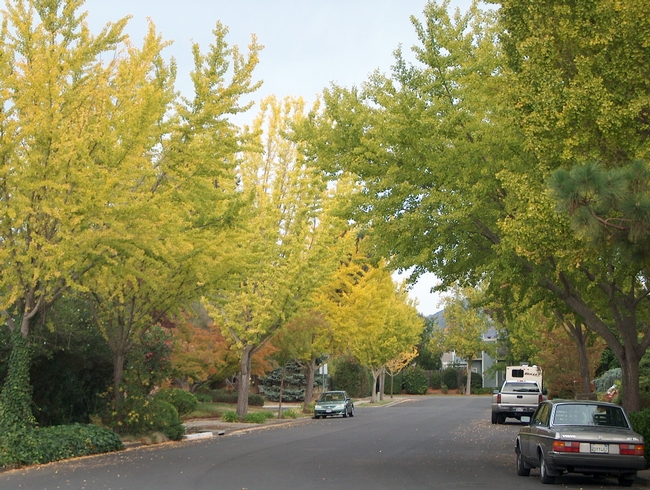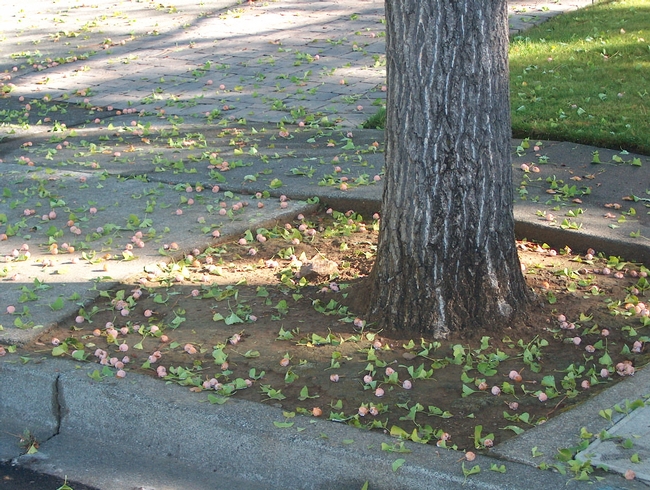
One of the main streets leading into my neighborhood has spectacular color in the fall due to the graceful ginkgo trees lining it. The scene is a bright, almost glowing yellow as the gingko leaves change color and drop. My daughter, at school in Chicago and homesick, begged me to send her a picture of that street in its fall glory.
Although Ginkgo biloba is the only extant species today, many ginkgo relatives have been found in the fossil record. A deciduous tree, the ginkgo is only distantly related to the other trees around us. It can grow nearly 100 feet tall and live for a millennium. It thrives in almost any temperate climate and is resistant to pollution and pests. These attributes have made male ginkgos popular in cities.
To produce fruit, a female gingko needs a male gingko nearby. The ovules on the female tree rise from a collar at the base and grow at the tips of stalks. The yellow pollen cones on the male tree hang like catkins. The trees are pollinated by the wind. In approximately four months, the fruit on the female tree will turn a pale yellow-green, soften and drop.
The ginkgo's unusual seeds have long been used for food in Asia. Research suggests that eating gingko seeds may help with Alzheimer's disease and increase circulation. Ginkgo extracts have played a crucial role in Chinese herbal medicine for centuries.
In my opinion, these seeds are the only unpleasant feature of the ginkgo tree. The smell of a great mass of rotting seeds can be overpowering. In the horticultural literature, the aroma is referred to in disparaging terms ranging from disagreeable to abominable. The culprit is butyric acid in the seed, the same compound that gives rancid butter its distinctive smell.
In our neighborhood, these trees become intermittent stink bombs from mid-August thru October. I say intermittent because only the female trees produce fruit. So the easy fix would be to plant only males, but it is not that simple.
Some people purchase a male tree only to discover, when it matures 25 to 30 years later, that it is actually a fruit-bearing female. When a male tree is grafted to female rootstock, sometimes the rootstock takes over. At first, the females may produce only 10 to 20 fruits—not too bad. But last year, I filled an entire yard-waste container every other week for four to six weeks in the fall.
Any tool, footwear or tire that comes in contact with the fruit will stink. It takes multiple washings to remove the stench. When my son was six years old, he and a friend decided to make “stink bombs.” They used my husband's tools to mash the ginkgo berries. To this day, 10 years later, when I open that tool box, I smell the unmistakable odor of gingko.
Removing the tree is one solution, but that can be expensive. And in our case, it was not an option. That being said, I absolutely had to find a reasonable solution to this yearly olfactory assault.
After some research, I learned about a product called Florel that contains ethephon, a growth regulator that reduces or eliminates fruit production. I had to purchase a “trombone”-type sprayer to reach the top of my 20-foot tree and follow the package directions about the timing of the applications.
As to the outcome of my labors, only time will tell. This past spring was my first attempt. Peering into the canopy recently, I noticed a marked reduction in fruit- laden branches.
Themale gingko'shardiness and beauty make it worth considering in a landscape plan. But keep in mind that your handsome “male” may turn out to be a badly behaved female.
Workshop:Napa County Master Gardeners will conduct a workshop on “Creating Wreaths from Your Garden” on Sunday, December 7, from 2 p.m. to 4 p.m., at the Yountville Community Center, 6516 Washington Street, Yountville. Learn which plants from your garden make good wreaths. Learn how to choose and prepare plant materials, and tips and tricks for designing and making easy wreaths for the holidays or other times of the year. Participants will create their own wreath to take home. To register, call the Parks & Recreation Department at 707-944-8712 or visit its website.
Master Gardeners are volunteers who help the University of California reach the gardening public with home gardening information. Napa County Master Gardeners ( http://ucanr.org/ucmgnapa/) are available to answer gardening questions in person or by phone, Monday, Wednesday and Friday, 9 a.m. to Noon, at the U. C. Cooperative Extension office, 1710 Soscol Avenue, Suite 4, Napa, 707-253-4143, or from outside City of Napa toll-free at 877-279-3065. Or e-mail your garden questions by following the guidelines on our web site. Click on Napa, then on Have Garden Questions? Find us on Facebook under UC Master Gardeners of Napa County.
Attached Images:
